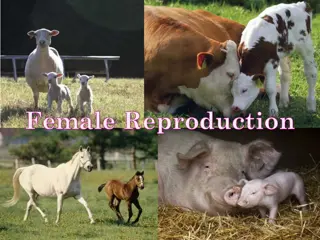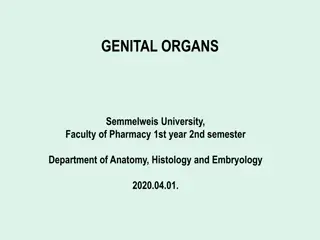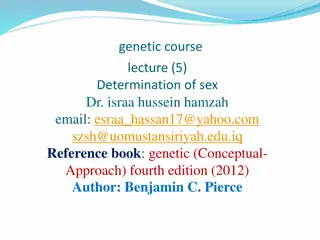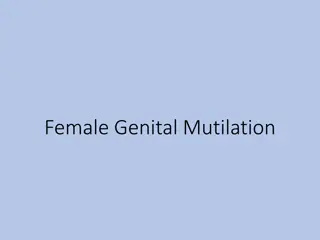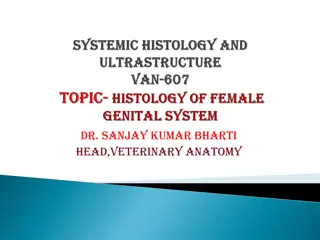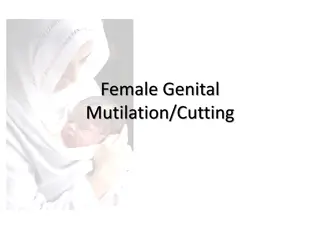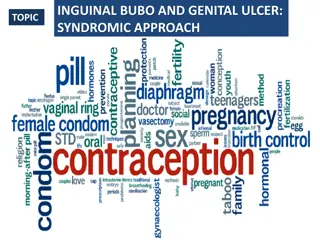Female Genital Tract Development and Sex Determination Overview
Professor Muhsin A. L-Sabba, a renowned gynecologist, delves into the normal development of the female genital tract, sex determination process, and related concepts. Learn about the differentiation of tissues into male or female organs, the role of hormones in puberty and secondary sex characteristics, and the critical genetic factors influencing sex development. Explore the rudimentary duct systems, chromosomal abnormalities, and the essential SRY gene's impact on gender determination. Discover the intricate journey from fertilization to the establishment of male and female reproductive systems.
Uploaded on Oct 01, 2024 | 0 Views
Download Presentation

Please find below an Image/Link to download the presentation.
The content on the website is provided AS IS for your information and personal use only. It may not be sold, licensed, or shared on other websites without obtaining consent from the author. Download presentation by click this link. If you encounter any issues during the download, it is possible that the publisher has removed the file from their server.
E N D
Presentation Transcript
NORMAL DEVELOPMENT OF FEMALE GENITAL TRACT PR ESN TED BY PROFESSOR MUHSIN A L- SA BBA K CONSULTANT GYNECOLOGIST BA SR A H MEDICAL SCHOOL 2 0 2 0- - - -20 2 1
Learning objectives:- 1-Explain how tissues differentiated in to male or female organs. 2- Name the rudimentary duct system in the embryo that is precursors to male or female internal sex organs. 3-What hormones that bring puberty and secondary sex character? 4-Able to define certain terms in the lecture like Mullerian, Wolffian, Mesonephric and so on.
SEX DETERMINATION SEX DETERMINATION Sex is determined at the time of fertilization to either a Sex is determined at the time of fertilization to either a female of female of 46 46XX or a male with a genotype of XX or a male with a genotype of 46 congenital sex anomalies according to the type of genotype that congenital sex anomalies according to the type of genotype that resulted after fertilization immediately. resulted after fertilization immediately. The development of reproductive system begin soon after The development of reproductive system begin soon after fertilization of the egg, fertilization of the egg, beginning to develop approximately one month after conception. beginning to develop approximately one month after conception. During the first meiotic division During the first meiotic division 46 46 XX divided in to and the male chromosome divide in to and the male chromosome divide in to 23 will be will be 46 46XX, XX,46 46XY, XY,46 46XX and XX and 46 46XY. XY. X chromosome is incompatible with life. X chromosome is incompatible with life. 46XY or to any other XY or to any other XX divided in to 23 23 X and X and 23 23 X and X and 23 23 Y so the result Y so the result 23 X X
But if non disjunction occurred during the first meiotic division the result will be 46 XX will divide to 23 XX and 22 0 while the 46 XY will divide to 23 X and 23Y. So the result will be as the followings:- 47 XXX called super female. 47 XXY called Klinfilter syndrome. 45 XO Turner syndromes 45 YO incompatible with life as any genotype pattern with absence of at least one
Female considered as fundamental sex that is without much chemical prompting all fertilized egg will develop into female. To become a male an individual must be exposed to cascade of factors initiated by a single gene called the SRY gene sex determining region of the Y chromosome because female don t have Y chromosome, they don t have SRY gene. Without functional SRY gene, an individual will be female.
Development of the gonads The mesenchyme cells of the coelom on the medial aspect of the intermediate cells mass and the underlying mesodermal cells proliferate to form the genital ridge which is apparent in the cervical and thoracic region of the 4-5 weeks old embryo. This elongated mass of the undifferentiated cells in the sex gland became later either testis or ovary depend on the presence or absence of HY antigen (Y chromosome or the absence respectively.
If Y chromosome is present the medullary portion will proliferate, If Y chromosome is present the medullary portion will proliferate, if if not, not, the cortical one will proliferate and lead to the formation of the cortical one will proliferate and lead to the formation of future ovary. future ovary. Sexual differentiation of the gonads is recognized by Sexual differentiation of the gonads is recognized by 6 6th weeks of gestation gestation 17 17 CRL ( CRL (crown rump length). crown rump length). The The ceolomic ceolomic cells forms the germinal ( cells forms the germinal (surface epithelium) the ovary while the underlying mesoderm give rise to the medulla. the ovary while the underlying mesoderm give rise to the medulla. th weeks of surface epithelium) cortex of cortex of
Differentiations of the gonads: Differentiations of the gonads:- - As early as the As early as the 5 5th week of gestation of the embryonic th week of gestation of the embryonic life the site of development of the gonads can be recognized as life the site of development of the gonads can be recognized as thickening of the thickening of the ceolomic ceolomic epithelium over the ventral aspect of epithelium over the ventral aspect of the the mesonephros mesonephros. . Amoeboid cells which are the primordial germ cells migrate to Amoeboid cells which are the primordial germ cells migrate to form distinct sex cords. form distinct sex cords. By By 16 16 weeks of gestation the primary weeks of gestation the primary oocyte can be distinguished these cells later form the oocyte can be distinguished these cells later form the granulosa granulosa cells. cells. At At 20 20 weeks of gestation the ovary is consist of weeks of gestation the ovary is consist of 7 7 million of germ cells but at birth they became germ cells but at birth they became 2 2 million and at puberty they are less than half million. they are less than half million. million of million and at puberty
Development of female genital tract: Development of female genital tract:- - In the absence of testis the In the absence of testis the Mullerian and the and the Wolffian Wolffian duct will obliterate leaving only Gardner duct cyst duct will obliterate leaving only Gardner duct cyst which are congenital ruminant of which are congenital ruminant of Wolffian The The Mullerian Mullerian duct will proliferate and will form future fallopian duct will proliferate and will form future fallopian tubes, tubes, uterus, uterus, cervix and upper cervix and upper 4 4/ /5 5th of the vagina while the lower 1 1/ /5 5th formed by the urogenital sinus. th formed by the urogenital sinus. In the presence of HY antigen and Y chromosome these will In the presence of HY antigen and Y chromosome these will produce the ante produce the ante Mullerian Mullerian factor ( factor (M. and this will intern lead to obliteration of the and this will intern lead to obliteration of the Mullerian proliferation of the medullary duct and formation of future proliferation of the medullary duct and formation of future testis. Mullerian system will develop system will develop Wolffian ducts. ducts. th of the vagina while the lower M.I. I.F) F) Mullerian Mullerian Inhibitory factor Inhibitory factor Mullerian duct and duct and testis.
So if HY is present male will develop and if testis is absent female genital tract will develop whether ovaries present or absent. So formation of female sex is passive process because it is formed in the absence of Y chromosome. By the 6th weeks of gestation the gonad still indifferent gonad but there after the gonads can be differentiated to either an ovary or testis. By the 12th weeks of gestation the cortical cells of the ovary will proliferate to a much greater extent than that of the male resulting in a crowded cells mass that cover the ovary.
Later sexual differentiation: Later sexual differentiation:- - The ovary will produce estrogen and progesterone under the influence of The ovary will produce estrogen and progesterone under the influence of gonado gonado- - trophin trophin hormones FSH and LH which are secreted by the anterior hormones FSH and LH which are secreted by the anterior pituitary gland. pituitary gland. These hormones will form the secondary sexual developments of the female These hormones will form the secondary sexual developments of the female which are breast buds, which are breast buds, pubic hair, pubic hair, axillary hair and finally menarche. axillary hair and finally menarche. Hypothalamus secrete GT RH ( Hypothalamus secrete GT RH (gonadotrophin gonadotrophin releasing hormone) the anterior pituitary to the anterior pituitary to secreate secreate gonadotrophin gonadotrophin FSH and LH ( stimulating hormone and stimulating hormone and lutinising lutinising hormone) hormone) which in turn affect the ovary to produce estrogen and progesterone all these event happened at puberty. produce estrogen and progesterone all these event happened at puberty. releasing hormone) which act on FSH and LH (follicular follicular which in turn affect the ovary to which act on
Audio visual stimulationhypothalamous stimulation------------ release GTRF (gonadotrophin releasing factor) ------------ stimulation to the pituitary gland --------- release FSH and LH ----------- - stimulation of ovary to release estrogen and progesterone (ovarian cycle)-----------stimulation to the uterus to initiate the menstrual cycle (proliferative and secretory phase)---------feedback inhibition for no more release of FSH.




